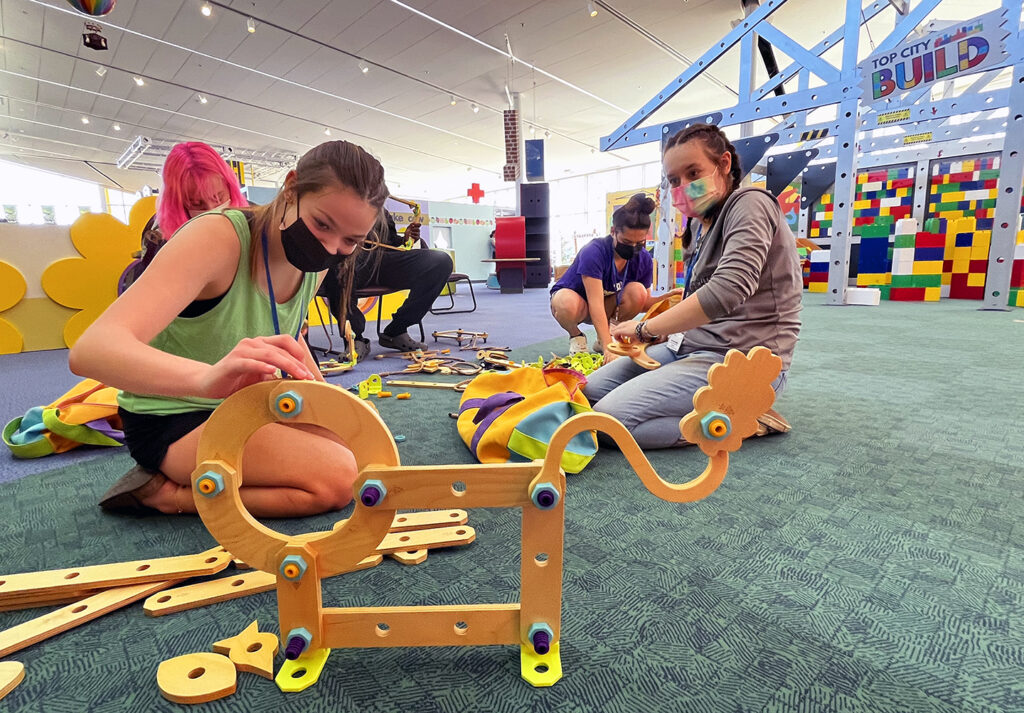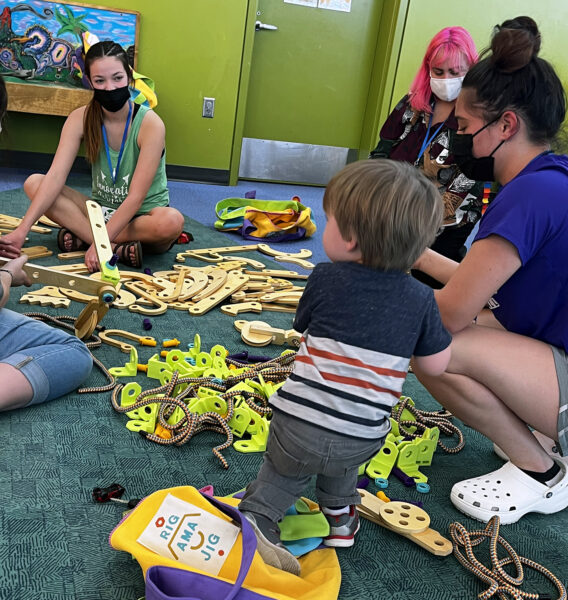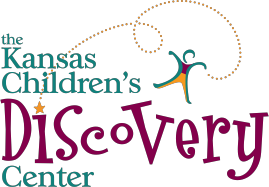
A tightly knit group of high school students from Topeka Unified School District 501 have been volunteering their time and energy to make the Kansas Children’s Discovery Center a better place for its young visitors, as well as honing their skills as potential future educators.
These six student leaders are members of the Topeka Center for Advanced Learning and Careers, or TCALC — an innovative program created through business partnerships to help teach youths about different career pathways they are interested in following. TCALC has several different professional pathways it offers to students, with this group representing the teaching pathway.
“These students are juniors and seniors in high school,” said Diane Kimsey, elementary math consulting teacher for TCALC. “They represent Highland Park, Topeka High and Topeka West. We meet every day for half a day and they all think that perhaps they would like to be teachers eventually. We have those who want to work with elementary, we have middle school dreamers and we have high school dreamers.”
So far in the four weeks they have been volunteering at the Discovery Center, the students have helped clean up the Discovery Center’s outdoor nature area, as well as creating educational materials for children. Last Wednesday, March 2, they taught young visitors of the Discovery Center about engineering using Rigamajig Basic Builder kits.
“Covid has kept us from being in the classrooms as much as we’d like to be, but at the same time we’ve had incredible opportunities,” Kimsey said. “For the last month, we’ve been here (at the Discovery Center) on Wednesdays, and we’re looking forward to this partnership to continue through the rest of the school year.”
The students came to the Discovery Center after contacting Visit Topeka to support Topeka Dino Days, a communitywide dinosaur exhibition. Staff at Visit Topeka connected the educators to the Discovery Center to support the museum as they opened the traveling Tiny Titans: Dinosaur Eggs and Babies.

Lessons learned
Volunteering at the Discovery Center has had its own highlights for the group.
Ainsley Schimmel, a junior at Topeka West, said her time with TCALC has taught her a lot of important lessons that will come in handy when she becomes a teacher.
“Just how to interact with kids, like classroom management,” Schimmel said. “And of course learning how to go through the curriculum design maps and read through those, because that’s really important when you become a teacher, to be able to pull things from that and create fun, engaging lessons for the students and not just boring ones.”
Topeka High junior Athena Stiles said she has most enjoyed putting together the educational materials for children during her time volunteering. Topeka West senior Manaia Isaia, meanwhile, said she had enjoyed her time spent at the Certified “Nature Explore” Outdoor Classroom, which is designed to encourage educational, outdoor play.
“Every time we go outside, I really like the outside,” Isaia said. “Especially the boat in the back and the zipline.”
Topeka West senior Emma Banka-Bayless said it’s been “a blast” volunteering at the Discovery Center.
“I’ve really enjoyed it,” she said. “It’s something new and we get to see different ways of creative learning. … And all the different things of how they incorporate learning into an activity, it’s really cool. Anyone from all ages can get excited about it, and I think that’s my favorite thing.”
Having future educators at the Discovery Center has benefits for both the volunteers and young visitors.
“Informal education, which is what we do here at the museum, is different than a classroom experience, for both educators and students,” said Caitlin Luttjohann, vice president of play and learning at the Discovery Center, who supervises the TCALC volunteers. “Open-ended, educational play allows children to write their own script. It ignites their curiosity. When these future educators facilitate that kind of play, they become better-rounded educators with more tools both in and out of the classroom. We also love having teens in that role because our visitors connect more to facilitators closer to their own age. The kids have loved playing with them!”
The Discovery Center relies on volunteers to help facilitate play, create educational materials and make the museum a safe and welcoming place for more than 95,000 annual visitors from all across the United States. Volunteers contribute more than 5,000 hours to the nonprofit children’s museum in a normal year.
“As a privately funded, nonprofit children’s museum, we truly rely on volunteers to be able to create play experiences for families,” Luttjohann said.
Making a community impact
Besides their volunteer efforts, the group has helped a lot of other children throughout the district, as well.
In October, the group taught STEM lessons to 3,000 Topeka Public Schools students — all of the district’s fourth, fifth and seventh graders — at the Kanza Education and Science Park.
“All of the stations we ran, they covered areas that the students will be tested on for the Kansas assessments for science,” Kimsey said. “They got to teach 3,000 children in one month, so that was pretty darn incredible.”
They have also taught art lessons at Quincy Elementary on Thursdays and put together winter kits for preschool through fifth-grade students at USD 501.
Highland Park junior Gabe Davis, a member of the school’s football team, said he wants to go into the teaching profession after having an educator touch his life personally.
“I wanted to get into education to make an impact on young children’s lives like teachers have before for me,” said Davis, who is interested in teaching second or third grade. “I had a teacher who made a heavy impact on me.
“In third grade, my mom got sick and she had to go to the hospital. The teacher noticed I was kind of down one day and she cheered me up. … That’s why I want to be an elementary-level teacher, because she made a heavy impact on me.”
He especially enjoyed his time teaching at the Kanza Education and Science Park, where he got to educate children about energy using a wind turbine.
Banka-Bayless, who wants to teach high school history or English, said she enjoyed working the “haunted gym” at Meadows Elementary this past fall.
“A lot of us got to dress up and then we got to go help with certain activities, helping kids throw basketballs, ride scooters, tape together and put down these cups to make these pyramids,” said Banka-Bayless. “We made them look like pumpkins out of the design with the orange and black, all in the Halloween theme. We really got to bring out the kids’ creative side with it and it was a lot of fun and enjoyable.”
Another project they worked on as a group involved coding DASH robots to perform a pre-planned dance routine to a clean version of the song “Get Into It (Yuh)” by Doja Cat. The group looks forward to leading DASH robot programs at the Discovery Center in the coming months.
Competitive drive
In November, the students picked through a list of items to compete in and chose a regional STEM competition through Educators Rising.
“They had to create a lesson, write a lesson plan, totally plan it and then teach it to students,” Kimsey said. “Then it had to be recorded and they analyzed what they would do differently next time, and then we went to MidAmerica Nazarene University in Olathe and competed against schools such as Blue Valley and Shawnee Mission, Lawrence, DeSoto, all over the northeast area. Four of the kids competed as partners, and two of them took first place in STEM and two of them took second place in STEM.”
Those students will now head to the state competition on Wednesday, March 9, at Ottawa University and compete as individuals, starting all over again on a new lesson plan. They chose to give their presentations to fifth-grade students at Meadows Elementary School and recorded it to be submitted. If they score in the top three at state, they would go on to national competition in Washington, D.C., which takes place at the end of June.
Schimmel, who is also on the dance team at West, says she wants to be an elementary school teacher when she begins her education career. She competed alongside Isaia at the regional competition. The pair took first place in their category at regionals after they put together a lesson on temperature and thermal temp that involved using differently color rags. As part of the lesson, they explained to the children why some colors attracted more heat than others.
For the state competition, however, Schimmel and Isaia had to come up with lesson plans individually.
“I did a density project and the kids made boats in groups of four and they learned about density through building the boats and having to use different materials while making their boats,” Schimmel said.
Isaia, meanwhile, taught a lesson on potential kinetic energy.
“I taught it to fifth-grade students over at Meadows Elementary,” said Isaia, who hopes to teach either elementary or middle-school kids. “I brought it sort of into like medieval times, so the kids would have to figure out how to make their own little catapult, that’s what we made the energy into. So I had them make the energy into a catapult and they had to figure out when they pull the catapult back which energy they were creating, and when they released it what energy were they then creating. After that, they had a little assessment over it and a word search to put it all together for them to fully think it through.”
For Stiles’ state project, she focused on the three states of matter in a particularly “delicious” way.
“So I decided to teach the three states of matter — liquid, solid and gas,” said Stiles, who plans to major in math in college. “To do that, I did ice cream. So me and the students created ice cream to show the gas — we also did root beer floats, so that’s where the gas came in with the carbonation bubbles — and then we also got to see the transformation from liquids to solids and solids to liquids. So there was lots of ‘magic’ happening there that the kids really liked.”
Stiles was recently inducted into the Mu Alpha Theta Honor Society and was nominated for a Tower Award this quarter by the math department at Topeka High for her achievements.

Thank you, TCALC!
The Kansas Children’s Discovery Center appreciates all the work that these young volunteers have put in and all that they are doing to become great educators for future generations. We also appreciate TCALC’s Diane Kimsey for her role in shaping young minds for the past 37 years as an educator.
“I don’t think any of us could imagine having a different teacher,” Banka-Bayless said.
To set up volunteer opportunities for your organization at the Discovery Center, contact us at (785) 783-8300 or visit https://kansasdiscovery.org/support/volunteer/ for more information.

